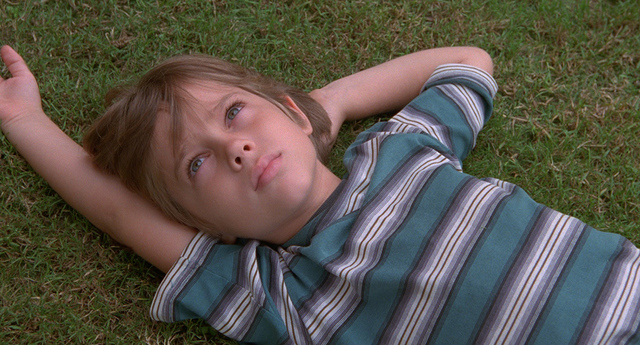The opening credit sequence of Richard Linklater’s latest film, Boyhood, is shot from the perspective of the main character Mason Jr. (Ellar Coltrane, 6 years old at the time) as he looks up into a blue sky. It’s a moment of calm before the stormier events and emotions that lie ahead in Linklater’s outstanding exploration of one boy’s adolescent years in a trying family situation.
You may have read about Linklater’s innovative filmmaking technique by now. He shot the movie over twelve years, taking a few weeks out of every year to film the story of Mason Jr., his sister Samantha (Lorelei Linklater), and their divorced parents, Olivia and Mason Sr. (Patricia Arquette and Ethan Hawke). As the film’s nearly three hour running time flies by, we see all four of them learn, grow, and fall in and out of love.
Linklater cleverly demarcates time using pop culture icons. A read-aloud of The Sorcerer’s Stone turns into a midnight release of The Half-Blood Prince, a lingerie catalogue becomes internet porn, and initial criticism of the Iraq war changes into support for Obama. Through all of these shifts, the director’s commitment to showing us multiple perspectives stands out.
Take, for example, an early fight between the parents. After the father takes his children out for an afternoon of bowling and fun, he brings them back to their permanent home with their mother. The tension between the couple mounts until they realize that they have too many issues to resolve them with Samantha and Mason Jr. present. They head outside, thinking that they have achieved privacy, but the children sneak upstairs and watch through an open window. It’s not hard to imagine what they’re saying to each other, but we don’t know precisely, because we see the fight from a distance and from the perspective of the kids. We don’t know the details of what’s going on, but we know that Olivia and Mason Sr. are fighting.
Linklater gives us the opposite point of view later on in the film. After a stern warning from Mason Sr. about texting and driving, we see Mason Jr. behind the wheel of his pick-up truck with his girlfriend, Sheena (Zoe Graham), showing him a picture on her iPhone. He looks away from the road to stare at the screen, and the camera lingers on a zoomed in shot of the phone. At this point, we’re getting the perspective of the concerned parent, terrified at the possibilities of his child on the open road. Linklater is too subtle of a filmmaker to make anything result from the boy’s distraction, but we’re terrified, for a moment, at what it could lead to. Boyhood is a film about what it’s like to grow up, to be sure, but it’s just as much about the experience of watching someone you love grow up.
As strong as these perspective shifts are, Linklater overreaches towards the end of the movie when he brings back a minor character from earlier in the film. The character’s second chance encounter with Mason Jr. and his family feels contrived, and it doesn’t come across as particularly satisfying. Mostly, it seems like Linklater wants to impress us with the extent to which he’s developed his central conceit—not only did he hang on to the main actors for twelve years, but he didn’t forget about the cast members with less screen time, either.
Still, it’s a single false note in a film that’s loaded with moments that ring true. The small details like hairstyles and favourite books feel just as immaculately planned out as the broader character arcs. Linklater goes beyond the sheer impressiveness and novelty of his filmmaking technique to deliver a coming-of-age story that depicts the struggles and joys of growing up as much as it shows the experience of watching a loved one go through those tribulations. The length of his shoot is a feat in and of itself, but the film’s true achievement is its fully realized portrayal of twelve years in the life of an American family.









